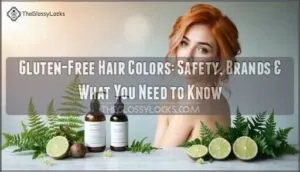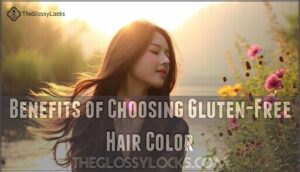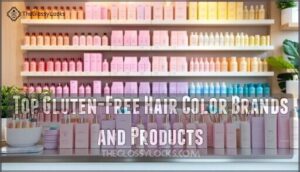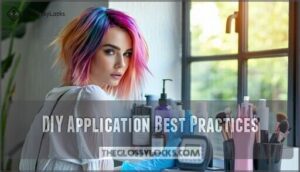This site is supported by our readers. We may earn a commission, at no cost to you, if you purchase through links.

That said, some brands add hydrolyzed wheat protein, wheat germ extract, or barley derivatives (look for Hordeum vulgare on the label) as conditioning agents. These ingredients don’t absorb through your scalp, so they won’t trigger an internal reaction. The real risk? Getting the product on your hands and then touching your mouth or face during application.
For people with dermatitis herpetiformis—a skin condition linked to celiac disease—even topical contact with gluten can cause itchy, painful blisters. That’s where certified gluten-free hair colors come in. Brands like Color X-Change, EcoColors, and DpHUE offer vegan, non-toxic formulas that deliver great color without the guesswork. Learning to spot problem ingredients turns a potentially stressful beauty routine into something you can actually enjoy.
Table Of Contents
- Key Takeaways
- What is Gluten and Why Avoid It?
- Why is Gluten Used in Hair Products?
- Can Gluten Be Absorbed Through Hair or Skin?
- Who Needs Gluten-Free Hair Colors?
- How to Identify Gluten in Hair Dyes
- Benefits of Choosing Gluten-Free Hair Color
- Top Gluten-Free Hair Color Brands and Products
- Tips for Safe Gluten-Free Hair Coloring at Home
- Frequently Asked Questions (FAQs)
- Is gluten-free hair color safe to use?
- How often should I use gluten-free hair color?
- Does gluten-free hair color damage the hair?
- Are gluten-free hair colors more expensive?
- How long does gluten-free hair color last?
- Can salons provide gluten-free coloring services?
- Do gluten-free dyes work on gray hair?
- Are gluten-free hair colors safe during pregnancy?
- Conclusion
Key Takeaways
- Gluten proteins in hair dye can’t penetrate your scalp, but hand-to-mouth contact during application creates a real exposure risk for people with celiac disease or gluten sensitivity—and those with dermatitis herpetiformis may experience itchy, blistering reactions from topical contact alone.
- Watch for hidden gluten sources like hydrolyzed wheat protein, triticum vulgare (wheat germ extract), Hordeum vulgare (barley derivatives), and beta glucan on ingredient labels, since these conditioning agents appear in conventional formulas even though most hair dyes don’t naturally contain gluten.
- Certified gluten-free brands like Color X-Change, DpHUE, and EcoColors eliminate wheat-based proteins while offering vegan, cruelty-free formulas that deliver vibrant, long-lasting color without compromising safety for sensitive individuals.
- Gluten-free doesn’t automatically mean gentler—hair damage depends on other chemical ingredients, not gluten content—but these formulas typically skip harsh additives and offer cleaner alternatives with natural plant-based options like henna that reduce irritation risk.
What is Gluten and Why Avoid It?
Gluten is a protein in wheat, rye, and barley that can trigger serious health issues for people with celiac disease, gluten sensitivity, or wheat allergies.
If you’re part of this group, you’ll want to check every product that touches your body—including hair dye—since even trace amounts can cause reactions in highly sensitive individuals.
Health Concerns for Sensitive Individuals
If you have celiac disease or gluten sensitivity, even the tiniest bit of gluten can cause a whole range of problems—from mild bloating to intense immune reactions. That’s why checking every product you use becomes a daily habit.
Here’s what gluten can do if you’re sensitive:
- Digestive issues like cramping, diarrhea, and nausea
- Skin irritation including dermatitis herpetiformis—a blistering rash
- Autoimmune reactions that damage the small intestine
- Neurological effects such as brain fog and headaches
Why is Gluten Used in Hair Products?
Gluten shows up in hair products because it works as a binding agent that holds formulas together and adds texture.
Wheat-derived proteins and extracts give hair dye a smoother consistency while boosting its conditioning properties, but you’ll need to watch for these ingredients if you’re gluten-sensitive.
Role of Gluten as a Binding Agent
Gluten works like scaffolding in your beauty products—the protein chains link up to create structure, which is why creams and gels feel smooth instead of watery when you spread them on. It’s the same molecular trick that makes bread dough stretchy.
If you’re gluten-sensitive, even small amounts in hair dye can trigger a reaction. That’s where gluten-free labeling becomes important—it lets you color your hair without playing guessing games.
Common Gluten-Derived Ingredients in Hair Dye
When you’re scanning ingredient labels for gluten sources in hair dye, hydrolyzed wheat protein often turns up—it can make up 0.5–2.5% of formulations and helps hair hold moisture. Hydrolyzed wheat protein is used for its moisture retaining properties in various cosmetic products.
Wheat germ extract (Triticum vulgare) and barley derivatives like Hordeum vulgare also sneak into products as conditioning agents. Oat derivatives such as Avena sativa carry cross-contamination risks, while dextrin and beta glucan may come from wheat-based starches.
Even vitamin E can be wheat-derived, so gluten-free hair care means double-checking every additive for hidden gluten.
Identifying Hidden Sources in Labels
Ingredient labels don’t always make gluten easy to spot. It shows up under technical names and derivative compounds that most people miss.
Watch for wheat-based ingredients like hydrolyzed wheat protein, triticum vulgare, or dextrin palmitate. Beta glucan usually comes from barley, and avena sativa means oats.
Gluten-free certification marks help, but checking ingredient lists for these hidden sources is still your strongest move when picking hair dye products.
Can Gluten Be Absorbed Through Hair or Skin?
Here’s the thing: gluten can’t actually penetrate your skin or hair shaft, according to current medical consensus.
That said, if you have dermatitis herpetiformis—a skin condition linked to celiac disease—or you’re dealing with cuts, irritation, or a habit of licking your fingers during application, trace amounts could potentially enter your system and cause problems.
Medical Consensus on Skin Absorption
Your skin isn’t going to absorb gluten from hair dye. Medical experts are clear on this—gluten proteins are massive molecules (30,000 to 80,000 Daltons, if you’re curious), and your skin barrier only lets through molecules smaller than 500 Daltons. It’s like trying to push a basketball through a keyhole.
Your skin barrier blocks gluten proteins from hair dye—they’re simply too large to penetrate, like pushing a basketball through a keyhole
There’s zero research showing celiac flare-ups from gluten touching your skin. Not a single documented case. Dermatology and gastroenterology organizations confirm that gluten in cosmetics poses no risk for people with celiac disease or gluten sensitivity.
When you dye your hair, any gluten sits on the surface and washes right off. No absorption happens, so there’s no immune response to worry about. Understanding gluten free options matters for people with gluten concerns, but your scalp isn’t letting anything through that could trigger a reaction. That’s genuinely reassuring.
Dermatitis Herpetiformis and Skin Reactions
While most people won’t absorb gluten through their scalp, there’s one notable exception that throws a wrench into the "skin is an impenetrable barrier" argument: dermatitis herpetiformis. This autoimmune skin condition triggers intensely itchy reactions, blistering rashes, and skin inflammation when gluten enters your system—and some people with this allergen sensitivity report flare-ups from topical gluten exposure.
The skin health connection matters here because direct contact can worsen dermatitis symptoms and skin irritation in vulnerable individuals seeking gluten-free options.
Most people won’t absorb gluten through their scalp. But dermatitis herpetiformis is different.
This autoimmune skin condition causes intense itching, blistering rashes, and inflammation when gluten enters your body—and some people with it report flare-ups even from shampoos or hair products containing gluten.
If you’re someone who breaks out in hives at the thought of accidental gluten exposure—or if your body treats even trace amounts like an unwelcome intruder—you need a game plan that goes beyond just reading labels. Here’s what matters most for gluten sensitivity and sensitive scalp protection:
- Patch-test every hypoallergenic option before committing to full application
- Check for allergen-free certification on gluten-free hair dye packaging
- Choose gentle formulas specifically designed for topical products
- Avoid wheat-derived ingredients if you have a gluten allergy
- Prioritize hair loss prevention by selecting proven, irritant-free brands
Who Needs Gluten-Free Hair Colors?
Gluten-free hair color isn’t just a trend—it’s a necessity for people with celiac disease, non-celiac gluten sensitivity, or wheat allergies who want to avoid accidental exposure.
Even if gluten doesn’t penetrate skin in most cases, those with dermatitis herpetiformis or heightened sensitivities may experience reactions from gluten-containing formulas, making certified gluten-free options a safer choice.
For people with celiac disease, non-celiac gluten sensitivity, or wheat allergies, gluten-free hair color is more than a passing fad—it’s a practical way to avoid unwanted exposure.
Around 73% of those living with celiac disease face accidental gluten exposure each year—sometimes multiple times monthly—triggering everything from severe digestive distress to neurological and psychological symptoms. Your body launches an autoimmune response when gluten enters the picture, causing inflammation that can last days. That’s why many with celiac or gluten sensitivity take a hard look at every product touching their skin, even if medical consensus says gluten can’t penetrate it.
| Condition | Prevalence | Key Symptoms |
|---|---|---|
| Celiac Disease | 2.1–2.4% (Finland) | Gastrointestinal, neurological, psychological |
| Gluten Sensitivity | 0.5–13% (varies by region) | Digestive irritation, fatigue, brain fog |
| Dermatitis Herpetiformis | 10–15% of celiac patients | Itchy, blistering skin lesions |
Even though intact skin won’t absorb gluten, hand-to-mouth contact during hair dye application remains a real risk. If you’re managing celiac symptoms or gluten sensitivity daily, choosing gluten-free hair color isn’t just cautious—it’s one less worry in a world full of hidden sources.
Wheat Allergy Vs. Gluten Intolerance
Wheat allergy and gluten intolerance aren’t interchangeable terms, even though they’re often lumped together in casual conversation. A wheat allergy triggers immediate immune responses—think hives or breathing issues—while gluten intolerance (including celiac disease) causes delayed digestive reactions. Here’s what sets them apart:
- Wheat reactions happen fast; gluten symptoms can take hours or days to surface
- Celiac diagnosis requires blood tests and biopsies; wheat allergy needs skin prick or IgE testing
- Intolerance testing for gluten sensitivity remains controversial and often inconclusive
- A gluten-free diet eliminates wheat, but wheat intolerance doesn’t always mean avoiding all gluten
- Gluten-free living becomes essential for celiacs; wheat allergy sufferers might tolerate rye or barley
Benefits for Allergy-Prone Individuals
For anyone who’s dealt with mystery rashes, itchy scalp reactions, or contact dermatitis, gluten-free hair color can be a breakthrough—even if celiac disease isn’t part of your story.
Hypoallergenic options with gentle formulas minimize allergy risk by eliminating wheat-derived ingredients that trigger sensitive skin.
Natural alternatives in gluten-free hair dye often skip harsh chemicals too, offering cleaner formulations that aid allergy prevention while delivering beautiful color without the itch.
How to Identify Gluten in Hair Dyes
Reading hair dye labels can feel like cracking a secret code, but knowing which ingredients hide gluten helps you protect your health without sacrificing style.
From hydrolyzed wheat protein to sneaky barley extract, we’ll show you exactly what to watch for and how certification standards keep you safe.
Hair dye labels are tricky to decode, especially when you’re hunting for hidden gluten. Ingredients like hydrolyzed wheat protein and barley extract can slip past you if you don’t know what to look for—but once you do, you can keep your hair gorgeous without risking your health.
Scanning hair dye labels can feel like decoding a chemistry textbook, especially when gluten hides behind ingredient names you’d never suspect. Watch for hydrolyzed wheat protein, beta glucan from wheat, barley extract, and Avena sativa—oats notorious for cross contamination. Even vitamin E and dextrin palmitate can harbor gluten derivatives.
If you have gluten sensitivity, mastering ingredient labeling isn’t just smart—it’s your freedom from hidden additives and toxic chemicals in hair dye ingredients.
Reading hair dye labels gets tricky when gluten sneaks in under names most people wouldn’t recognize. Look out for hydrolyzed wheat protein, beta glucan from wheat, barley extract, and Avena sativa—oats that often pick up gluten during processing.
Vitamin E and dextrin palmitate can also contain gluten derivatives.
When you’re shopping for gluten-free hair dyes, you’ll want products backed by real certification—not just marketing claims. The FDA requires gluten-free cosmetics to contain less than 20 ppm of gluten, but stricter programs like GFCO test below 10 ppm. These certifications involve rigorous gluten testing, facility audits, and ongoing regulatory compliance to protect your health.
Look for these trust signals:
- GFCO or NSF certification marks on the label—proof of third-party accreditation standards and transparent gluten testing
- Batch traceability that ensures every bottle meets label requirements and celiac disease management protocols
- Annual re-testing so formulations stay safe even as ingredients change
- Clear ingredient disclosure that eliminates guesswork for anyone following a gluten free diet
Benefits of Choosing Gluten-Free Hair Color
Choosing gluten-free hair color isn’t just about avoiding potential reactions—it’s about embracing formulations that work with your body, not against it.
These products generally skip harsh additives and gluten-derived fillers, delivering cleaner color while reducing the risk of irritation for sensitive individuals.
When you pick gluten-free hair color, you’re doing more than dodging reactions.
You’re choosing formulas built around cleaner ingredients—ones that skip harsh fillers and cut down on irritation, especially if your scalp’s sensitive.
When you cut gluten out of your hair color routine, you’re not just dodging a protein—you’re closing the door on a whole cascade of potential reactions that can turn a simple touch-up into an itchy, inflamed nightmare.
Hypoallergenic options with nontoxic hair color ingredients offer real skin safety for sensitive scalp care. An allergy patch test still matters, but gluten-free hair dye stacks the deck in your favor with gentle formulas that prioritize allergy prevention and hair color safety for truly allergen-free results.
Skip gluten in your hair color, and you’re avoiding more than just a protein trigger. You’re cutting off a chain reaction that can leave your scalp red, itchy, and irritated after what should’ve been a routine dye job.
Hypoallergenic options with nontoxic hair color ingredients offer real skin safety for sensitive scalp care. An allergy patch test still matters, but gluten-free hair dye gives you better odds with gentle formulas built around allergy prevention and hair color safety for truly allergen-free results.
If you’re committed to keeping animal-derived ingredients out of your beauty routine, you’ll be glad to know that many gluten-free hair dyes align perfectly with vegan and plant-based values.
Brands like Color X-Change and EcoColors prioritize cruelty-free products that skip animal testing entirely.
These natural hair coloring options often feature plant-based formulas—think henna and herbal extracts—that fit seamlessly into an eco-friendly, vegan lifestyle without compromise.
Gentle, Non-Toxic Formulations
Many gluten-free hair dyes go beyond just removing wheat proteins—they ditch harsh chemicals altogether, giving you a cleaner, kinder coloring experience.
You’ll find eco-friendly formulas packed with natural ingredients like henna, plant extracts, and mineral pigments that deliver vibrant color without ammonia or PPD.
These nontoxic hair color options work beautifully for sensitive skin care, reducing irritation while offering allergen-free, permanent hair dye results that don’t compromise your health or values.
Top Gluten-Free Hair Color Brands and Products
If you’re ready to make the switch, you’ll want brands that deliver both safety and color payoff.
Here’s a breakdown of trusted gluten-free options that work for various preferences—from vibrant semi-permanent shades to gentle, plant-based formulas.
Color X-Change
Color X-Change pioneers new territory as a triple-threat brand—vegan, cruelty-free, and completely gluten-free—so you don’t have to compromise your values when you’re ready to switch up your look. Their product range delivers vibrant, long-lasting color options that work beautifully for anyone embracing gluten-free living without harsh chemicals.
What makes Color X-Change stand out:
- Vegan formulas free from animal-derived ingredients and gluten
- Wide color options from natural tones to bold, adventurous shades
- Cruelty-free certification guaranteeing ethical production practices
- Clean ingredient transparency making label-reading straightforward for sensitive individuals
DpHUE
dpHUE walks the line between salon-quality results and clean beauty principles, offering gluten-free formulas that don’t ask you to compromise on vibrancy or longevity.
Their semi-permanent options and color depositing treatments let you revitalize your look without the commitment of permanent hair dye.
You’ll find everything from subtle gloss boosters to bold statement shades—all crafted to play nice with sensitive systems while delivering professional-grade pigment.
EcoColors
EcoColors steps up for those who want their hair color squeaky clean—think gluten-free, sulfate-free, and paraben-free all in one tube. Their PPD-free formulas deliver rich, lasting color without the harsh chemicals that can trigger reactions.
Plus, you’re looking at eco-friendly packaging that doesn’t make you choose between gorgeous hair and a cleaner conscience. It’s color that actually respects your body.
Garnier Fructis Gluten-Free Lines
Garnier Fructis brings gluten-free hair color to drugstore aisles, proving you don’t need to sacrifice convenience or budget for peace of mind. Their gluten-free options span multiple product variations, making it easier to find your shade without scanning ingredient lists for hours.
Here’s what makes Garnier formulas stand out:
- Clear gluten-free labeling on select Fructis ingredients for quick identification
- Extensive hair color range across permanent and semi-permanent formulas
- Accessible pricing that won’t break the bank while keeping you safe
Henna Color Lab
Henna Color Lab breaks the mold with plant-powered formulas that skip the gluten entirely while delivering rich, long-lasting color. Their henna products and natural dyes come in multiple color options, from auburn to deep brunette, giving you hair safety without compromise. Each batch undergoes gluten testing to guarantee GlutenFree living stays intact.
| Feature | Benefit | Why It Matters |
|---|---|---|
| Plant-based henna | No synthetic chemicals | Gentler on sensitive scalps |
| Certified GlutenFree | Passes 20 ppm standards | Safe for celiac individuals |
| Multiple shades | Customizable natural hair coloring | Flexibility without risk |
| Zero ammonia | Low irritation formula | Healthier GlutenFree hair dye option |
Natural Ayurvedic Hair Dye Kit
When ancient Ayurvedic wisdom meets modern gluten-free demands, MATRU AYURVEDA’s natural henna and indigo kit delivers a chemical-free coloring solution that’s as pure as it gets. This vegan-friendly permanent hair dye features 100% natural henna and indigo powders—no ammonia, PPD, or metallic salts—cultivated in India specifically for hair nourishment and natural hair coloring.
- Break free from harsh chemicals with herbal formulas that strengthen dry, dull hair
- Reclaim your confidence knowing it’s gluten-free and cruelty-free
- Embrace authenticity with Ayurvedic ingredients trusted for centuries
Tips for Safe Gluten-Free Hair Coloring at Home
Coloring your hair at home doesn’t have to feel like walking through a minefield when you’re gluten-sensitive. With the right prep and a few smart strategies, you can achieve salon-quality results while keeping gluten exposure at bay.
DIY Application Best Practices
If you’re gluten-sensitive, dyeing your hair at home probably sounds risky. But it doesn’t have to be.
A little homework and some practical steps can help you get great color without the gluten worry.
Getting your gluten-free hair color home doesn’t mean you’re ready to begin—proper prep work can make the difference between a perfect finish and a patchy disaster.
Start with clean, dry hair—no conditioner or styling products that might create barriers. Do a patch test 48 hours before applying your nontoxic hair color to check for allergic reactions.
Gather gloves, a timer, and application tools to protect yourself and guarantee even coverage for allergy-friendly hair color results.
Avoiding Cross-Contamination
Even if you’ve nailed the perfect application technique, your gluten-free hair color can still betray you if you’re not careful about what it touches before, during, and after the process. Cross contamination happens faster than you’d think, especially if you share your bathroom with others using conventional products.
Here’s how to keep your gluten-free hair dye options truly safe:
- Dedicate tools exclusively – Keep separate brushes, bowls, and gloves for your gluten-free hair care routine
- Sanitize surfaces thoroughly – Wipe down counters and sinks before mixing to remove residue from regular products
- Check ingredient sourcing – Verify gluten-free certification on every product touching your hair during the process
- Store separately – Keep your gluten sensitivity-friendly supplies away from conventional hair products to prevent accidental exposure
Safe handling practices matter because manufacturing protocols can’t protect you once products leave the factory.
Selecting The Right Shade and Formula
Choosing the right shade isn’t just about matching your roots—it’s about understanding how gluten-free formulas interact with your hair’s unique chemistry. Permanent hair dye delivers lasting results, while natural hair coloring options offer gentler alternatives. Check product reviews and ingredient lists carefully—gluten-free hair dye options vary widely in color theory application.
| Formula Type | Best For | Shade Matching Tip |
|---|
Picking a shade isn’t just about matching your roots. It’s important to know how gluten-free formulas might react with your hair’s chemistry.
Permanent dyes stick around for the long haul, while natural options are easier on your hair. Always read reviews and scan the ingredient list—gluten-free hair dyes can be surprisingly different when it comes to color results.
Extra Conditioning and Nourishment
Gluten-free hair dyes won’t strip your strands the way harsh chemicals can, but they still need backup from a solid conditioning routine to keep your color vibrant and your hair healthy.
Deep conditioning treatments and hair masks loaded with nourishing oils help lock in moisture after natural hair coloring. Look for hydrating products with natural preservatives that complement your gluten-free product selection—your hair health depends on that extra nourishment, especially when you’re embracing gentler, more natural formulas.
Frequently Asked Questions (FAQs)
Is gluten-free hair color safe to use?
In light of rising gluten sensitivity awareness, you might wonder if topical products pose hair dye risks. Yes, gluten-free hair dye options are safe—they eliminate potential skin irritation and allergic reactions while delivering effective color.
These glutenfree hair care formulas prioritize color safety without compromising results.
How often should I use gluten-free hair color?
Frequency depends on your hair type and the formula you choose. Permanent color usually lasts six to eight weeks, while semi-permanent fades faster.
- Fine hair: Space sessions further apart to minimize damage control
- Coarse or gray-resistant hair: May need touch-ups every four weeks
- Sensitive scalp: Extend dye intervals between applications
- Vibrant fashion shades: Revive color weekly with gluten-free hair care boosters
Follow usage guidelines on your gluten-free hair dye options for best results.
Does gluten-free hair color damage the hair?
Most hair dye formulas—gluten-free or not—carry similar hair damage risk due to chemical reactions that alter hair porosity and structure.
Gluten-free hair color doesn’t automatically mean gentler; it’s the other ingredients that determine how your strands hold up.
Are gluten-free hair colors more expensive?
Price points vary widely across the market. Cost comparison reveals that gluten-free hair dye options aren’t inherently pricier—brand variations and formulation quality drive the differences, not gluten-free status alone.
- Budget options exist in drugstore lines like Garnier Fructis, proving gluten-free hair care doesn’t require premium spending
- Price factors include ingredient sourcing, certifications, and brand positioning rather than gluten content
- Premium alternatives like EcoColors charge more for organic formulations, which happen to be gluten-free
- Gluten sensitivity needs don’t automatically mean higher costs—many affordable gluten-free product selection choices exist
- Gluten-free hair styling products across price ranges offer accessible options for every budget
How long does gluten-free hair color last?
One truth stands eternal: color longevity depends entirely on formula type, not gluten content. Permanent gluten-free hair dye options last until new growth appears, while semi-permanent gluten-free hair care products fade gradually over 4-8 weeks.
Hair porosity affects color retention and fading rates regardless of ingredients.
Can salons provide gluten-free coloring services?
Yes, salons can offer gluten-free hair dye options if trained cosmetologists stock certified products and conduct proper color consultation.
Client safety depends on salon industry awareness of gluten-free product selection and cross-contamination prevention during application.
Do gluten-free dyes work on gray hair?
Gray hair can be notoriously stubborn, but gluten-free formulas work just as effectively as conventional dyes. Permanent gluten-free hair color delivers excellent gray coverage through proper color deposit, while semi-permanent options fade gradually.
Your hair porosity affects results—coarser gray hair may need longer processing times. Allergy-friendly hair color brands handle gray root touch-ups beautifully.
Are gluten-free hair colors safe during pregnancy?
Pregnancy safety is a top priority, and most medical professionals recommend waiting until after the first trimester to use any hair dye.
Gluten-free options don’t pose unique risks to fetal development through gluten transfer, but standard hair dye risks and prenatal precautions still apply for those with celiac disease seeking allergy-friendly hair color.
Conclusion
Breaking free from gluten doesn’t mean sacrificing vibrant color—think of it as your personal declaration of independence from outdated formulas.
Gluten-free hair colors protect you from hidden wheat proteins while delivering salon-quality results that let you express yourself without worry.
Whether you’re managing celiac disease, dodging dermatitis herpetiformis, or simply choosing cleaner beauty products, certified brands give you control over what touches your skin.
Going gluten-free with your hair color isn’t about giving up anything—it’s about finding formulas that actually work for your body. No wheat proteins sneaking into your routine, just reliable color that does what it promises.
Gluten-free options protect against hidden wheat-based ingredients while delivering results that match what you’d get at a salon. You’re not compromising on quality—you’re just being smarter about what you use.
Whether you have celiac disease, deal with dermatitis herpetiformis, or prefer cleaner products in general, certified brands give you peace of mind. You know exactly what’s in the bottle.
Check ingredient lists, watch out for cross-contamination during manufacturing, and color with confidence. It’s that straightforward.












